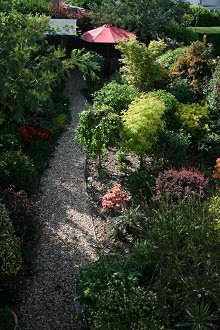It was fifteen years ago that our family went for a holiday to Majorca. We were staying in the small town of Puerta Pollensa, in the north of the island.
During the trip we visited a friend of Celias, a lovely woman called Antonia. She lived in a typical Spanish home of the region. A single story house, painted white, and with green shutters on every window. The garden was enclosed by a white wall, and typically had lemons, olives and nisparo.
We didn't speak Spanish, and she didn't speak English, but thankfully Celia spoke both, and so conversations were possible, and a lovely afternoon was had catching up with each others lives.
She cooked us one of the best paellas I have ever had, and it was shared around a large table with some of her family.
Of course, I took an interest in her garden, and in particular the Nisparo (or Loquat as it's also known), which I had never seen before. She had brought a bowl of it's fruit in for pudding, and the sweet and unusual flavour had made me curious about the plant. With Antonias permission, I picked a few fruit to take home, some to eat, and some to grow if I could.
Nisparo - Eriobotrya japonica
The seeds are quite beautiful in themselves, a shiny bronze colour. I planted one single seed, and have waited....and waited.
Nisparo are difficult to get to fruit in this country, and would normally take around twelve years to reach a mature enough age to do so. I looked out of our kitchen window a couple of days ago, and there at the end of the garden I spied fruit forming....fifteen years later.
The seeds on our tree
Yay!...now they just need to ripen.


























































Wow, you must have been very excited to see them. Just one seek planted and it came to fruition it was meant to be :)
ReplyDeleteI must admit to running indoors to tell Amanda about it, and we never thought the climate would allow it to fruit!
DeleteHello Gary:
ReplyDeleteThis is a wonderful story and how exciting that, at long last, your own fruit is forming. After such a wait we really do hope that all will be well and nothing go amiss. You deserve that for your patience alone.
Good morning Jane and Lance,
DeleteWe have certainly waited a long time. Nisparo grow well in this country, but don't often have the correct heat/rain balance to fruit. Sadly now though Antonia has passed away, but hopefully we shall once again enjoy fruits from her tree.
HURRAY! That's great! You did not cut the tree down because it wasn't producing, you let it grow and now it is bringing forth its fruit when it was ready.
ReplyDeleteFlowerLady
Hi Lorraine,
DeleteThere were times when we were tempted to cut it down, but the leaves are rather attractive, even If it never fruited. I suppose it also held some fond memories for us. Plants eh?
Is it growing in the ground? Or do you have it in a pot that you bring indoors?
ReplyDeleteGood evening Doc,
DeleteIt's growing in the ground, and is now about 12ft x 10ft.
What a discovery and so wonderful that you got the tree to grow. Fruit is a super bonus!
ReplyDeleteGood morning Sherlock,
DeleteGetting the tree to grow was reward enough, but the fruit forming is the icing on the cake.
i guess climate change can be advantageous for some!
ReplyDeletei congratulate you on your patience
Hi Kylie,
DeleteClimate change is becoming very apparent here in the UK, although those in power would deny it. Thanks for dropping by.
This comment has been removed by the author.
ReplyDelete